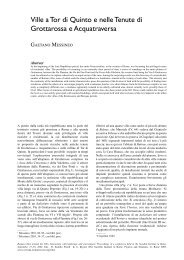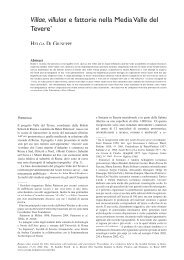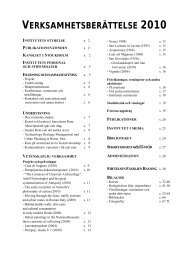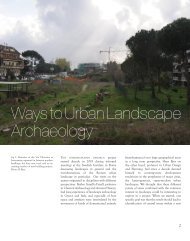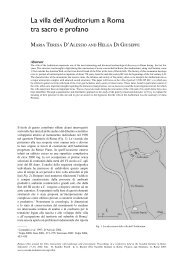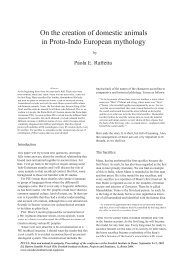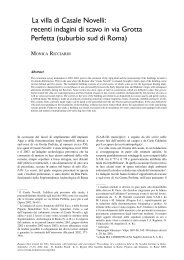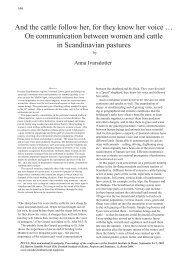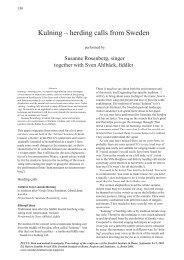When the rest of the world thought male ibex, why did the people of ...
When the rest of the world thought male ibex, why did the people of ...
When the rest of the world thought male ibex, why did the people of ...
You also want an ePaper? Increase the reach of your titles
YUMPU automatically turns print PDFs into web optimized ePapers that Google loves.
154<br />
<strong>When</strong> <strong>the</strong> <strong>rest</strong> <strong>of</strong> <strong>the</strong> <strong>world</strong> <strong>thought</strong> <strong>male</strong> <strong>ibex</strong>,<br />
<strong>why</strong> <strong>did</strong> <strong>the</strong> <strong>people</strong> <strong>of</strong> San Giovenale<br />
think fe<strong>male</strong> sheep?<br />
by<br />
Kristina Berggren<br />
To Geltrude Mantovani and Felice Tedeschi, Blera<br />
Fig. 1. Ibex. Detail <strong>of</strong> petroglyph from Har Karkom, site 29. Drawing<br />
by R. Bastoni Brioschi.<br />
Abstract:<br />
It is commonly believed that images without text cannot be interpreted.<br />
However, I have discovered that using <strong>the</strong> technique <strong>of</strong> dream<br />
interpretation worked out by C.G. Jung and practiced by psychologists<br />
<strong>of</strong> his school all over <strong>the</strong> <strong>world</strong>, some knowledge can be gained. In<br />
this article, I present two prehistoric images, <strong>the</strong> <strong>ibex</strong> and <strong>the</strong> ewe, one<br />
<strong>male</strong>, <strong>the</strong> o<strong>the</strong>r fe<strong>male</strong>; one found as a petroglyph in all <strong>the</strong> high mountains<br />
<strong>of</strong> Asia and South-West U.S.A, or incised on Near Eastern seals;<br />
<strong>the</strong> o<strong>the</strong>r made in pottery and found only in <strong>the</strong> pre-Etruscan site <strong>of</strong><br />
San Giovenale in Central Italy. The <strong>ibex</strong> goes back to <strong>the</strong> Palaeolithic<br />
Period, while <strong>the</strong> ewe is only present during three- or four hundred<br />
years in <strong>the</strong> Late Bronze Age. They stand in opposition to each o<strong>the</strong>r,<br />
giving two different – and similar – answers to <strong>the</strong> eternal question <strong>of</strong><br />
<strong>the</strong> significance <strong>of</strong> life and death.<br />
[First unnumbered note:] I was given <strong>the</strong> rare privilege<br />
to present my work both orally and with a poster for<br />
which I give my warmest thanks to <strong>the</strong> director <strong>of</strong> <strong>the</strong><br />
Swedish Institute, pr<strong>of</strong>essor B. Frizell. I am particularly<br />
grateful to Mrs. Rosetta Bastoni Brioschi from <strong>the</strong><br />
Centro Camuno di Studi Preistorici who, among o<strong>the</strong>r<br />
things, has given me permission to publish some <strong>of</strong> her<br />
drawings from Har Karkom. The hypo<strong>the</strong>ses are my<br />
own. It is with greatest joy that I dedicate this work to la<br />
commare, Mrs. Geltrude Mantovani and il compare, Mr.<br />
Felice Tedeschi, Blera, who have taught me much more<br />
than <strong>the</strong>y realize.<br />
Fig. 2. Pottery cup with handle in form <strong>of</strong> a ewe. San Giovenale inv.<br />
no.V57:37. Reconstruction and drawing by K. Berggren.<br />
All over <strong>the</strong> nor<strong>the</strong>rn hemisphere – in Asia and in North<br />
America 1 – above <strong>the</strong> places where goats have <strong>the</strong>ir<br />
habitat we find petroglyphs <strong>of</strong> <strong>the</strong> <strong>male</strong> <strong>ibex</strong> (Fig. 1).<br />
The earliest one, from <strong>the</strong> Upper Paleolithic period,<br />
is on <strong>the</strong> mountain <strong>of</strong> Helan Shan, in <strong>the</strong> province <strong>of</strong><br />
Ninxia, in North-West China; 2 o<strong>the</strong>r early ones, dated in<br />
<strong>the</strong> Neolithic period, have been found in Kilwa, on <strong>the</strong><br />
frontier between Saudi Arabia and Jordan, and inside <strong>the</strong><br />
Grotta Palandi in East-Central Turkey. 3 All <strong>the</strong> o<strong>the</strong>rs are<br />
probably made between <strong>the</strong> third and early first millennium<br />
BCE.<br />
However, <strong>the</strong> <strong>ibex</strong> is not only engraved on rocks,<br />
but also on seals especially in <strong>the</strong> Near East. Here one<br />
or two <strong>of</strong> <strong>the</strong>m <strong>of</strong>ten stand below a tree underneath <strong>the</strong><br />
lunar crescent. 4 From here <strong>the</strong> image travels to Minoan<br />
Crete and Mycenean Greece where it survives into <strong>the</strong><br />
early sixth century BCE on pottery made on <strong>the</strong> island <strong>of</strong><br />
Rhodes, in Corinth, and exported to <strong>the</strong> Etruscans. 5<br />
Central Italy shows ano<strong>the</strong>r picture. The Swedish<br />
excavations <strong>of</strong> <strong>the</strong> pre-Etruscan village in San Giovenale<br />
have brought forth many pottery handles belonging to<br />
cups and representing ewes (Fig. 2). 6 In <strong>the</strong> late eight<br />
century BCE, <strong>the</strong>y are replaced by handles depicting<br />
rams <strong>the</strong>n common all over central Italy.<br />
PECUS. Man and animal in antiquity. Proceedings <strong>of</strong> <strong>the</strong> conference at <strong>the</strong> Swedish Institute in Rome, September 9-12, 2002.<br />
Ed. Barbro Santillo Frizell (The Swedish Institute in Rome. Projects and Seminars, 1), Rome 2004.<br />
www.svenska-institutet-rom.org/pecus
Kristina Berggren<br />
155<br />
Fig. 3. Ibex from two different periods. Har Karkom, site 38:2, detail<br />
<strong>of</strong> petroglyph. Drawing by R. Bastoni Brioschi.<br />
Fig. 4. Ibex. Har Karkom, site 45. Detail <strong>of</strong> petroglyph. Drawing by<br />
R. Bastoni Brioschi.<br />
In this paper I will present my hypo<strong>the</strong>sis about <strong>the</strong> significance<br />
<strong>of</strong> <strong>the</strong> two so different animals as <strong>the</strong> horned<br />
<strong>ibex</strong> in Asia and North America and <strong>the</strong> ewe in San<br />
Giovenale using <strong>the</strong> same technique worked out by C.G.<br />
Jung that I have used in an earlier paper. 7 This means<br />
that I’ll consider <strong>the</strong> images not only as images <strong>of</strong> <strong>ibex</strong><br />
and ewes, but as symbols, that is, analogies taken from<br />
our physical <strong>world</strong> to answer such unanswerable questions<br />
as: Where was I before I was born? What happens<br />
in death? What does it mean to be human? It is a language<br />
that most <strong>of</strong> us, Europeans and North Americans,<br />
have forgotten. The Chinese still understand it; Hindus,<br />
Buddhists and Taoists express <strong>the</strong>mselves in it; all o<strong>the</strong>r<br />
<strong>people</strong> except us use it and my hypo<strong>the</strong>sis is that this is a<br />
valid interpretation <strong>of</strong> prehistoric images. This does not,<br />
however, make it easy for us to learn because, although,<br />
as Alleau points out it is a logical language, its logic is<br />
not <strong>the</strong> one we are used to. 8 A symbol is not a sign and<br />
nei<strong>the</strong>r is it an allegory. A symbol always associates<br />
o<strong>the</strong>r symbols to itself and asks new questions – and to<br />
complicate <strong>the</strong> issue <strong>the</strong> symbol also includes <strong>the</strong> opposite<br />
<strong>of</strong> itself, that is, not only birth but also death; not<br />
only peace but also violence.<br />
The ancient meanings <strong>of</strong> <strong>the</strong> word “symbol” makes<br />
this clear. The word is usually said to mean a coin divided<br />
in two pieces, but as <strong>the</strong> excavations in <strong>the</strong> A<strong>the</strong>nian<br />
Agora have shown, it was really a small flat piece <strong>of</strong> pottery<br />
divided while <strong>the</strong> clay was still moist so that only<br />
<strong>the</strong>se two pieces could fit toge<strong>the</strong>r. 9 One stayed with <strong>the</strong><br />
host; <strong>the</strong> o<strong>the</strong>r went to a friend in ano<strong>the</strong>r city. In a time<br />
when it really was important to have friends in o<strong>the</strong>r cities,<br />
<strong>the</strong>se tokens were important enough to be inherited.<br />
However, this is not <strong>the</strong> only use <strong>of</strong> <strong>the</strong> word. “Symbol”<br />
was also used as a nautical term, referring to <strong>the</strong><br />
joint where <strong>the</strong> vertical and horizontal beams holding<br />
<strong>the</strong> sail are united and in The Republic (425c) Plato uses<br />
<strong>the</strong> word meaning to make a deal, a contract. Making a<br />
contract means that many different and opposite words<br />
flow toge<strong>the</strong>r between <strong>the</strong> seller and <strong>the</strong> buyer until with<br />
a handshake <strong>the</strong>y are all united in one deal. The idea <strong>of</strong><br />
words flowing toge<strong>the</strong>r is similar to Pausanias’ description<br />
<strong>of</strong> <strong>the</strong> boundary between Lacedaemon and Tegea<br />
in <strong>the</strong> North <strong>of</strong> Peloponnesus: “ The river Alfeios is between<br />
Lacedaemon and Tegea. It begins in Phylace and<br />
not far from its source ano<strong>the</strong>r stream flows into it from<br />
many springs. Therefore this place is called ‘Symbols’”.<br />
(8.54.1). The flowing <strong>of</strong> many waters into one place is a<br />
symbol as are <strong>the</strong> words that make up <strong>the</strong> deal.<br />
In his Roman Antiquities (8. 38), Dionysius <strong>of</strong> Halicarnassus<br />
uses <strong>the</strong> word about <strong>the</strong> statues <strong>of</strong> <strong>the</strong> gods.<br />
The gods are <strong>the</strong> identity-cards <strong>of</strong> <strong>the</strong> believers and <strong>the</strong><br />
focal point <strong>of</strong> <strong>the</strong> city united round <strong>the</strong> symbols, <strong>the</strong><br />
statues <strong>of</strong> <strong>the</strong> gods. To speak in symbols <strong>the</strong>refore means<br />
to unite two different things into a whole: Two strangers,<br />
<strong>the</strong> vertical with <strong>the</strong> horizontal beam, two opinions making<br />
one deal, two streams <strong>of</strong> water, <strong>the</strong> physical statues<br />
<strong>of</strong> <strong>the</strong> gods incorporating <strong>the</strong>ir non-physical presence,<br />
<strong>the</strong> image <strong>of</strong> a horned <strong>ibex</strong> or a ewe with <strong>the</strong> question<br />
what life is about.<br />
Looking for analogies to <strong>the</strong> <strong>ibex</strong>, we are helped by<br />
<strong>the</strong> petroglyphs found on Har Karkom in <strong>the</strong> nor<strong>the</strong>rn<br />
part <strong>of</strong> <strong>the</strong> Sinai peninsula. According to Emmanuel<br />
Anati, who has lead <strong>the</strong> work here since 1980, this is <strong>the</strong><br />
mountain that <strong>the</strong> editors <strong>of</strong> Exodus have described as<br />
Sinai, <strong>the</strong> mountain where Moses receives <strong>the</strong> Tables <strong>of</strong><br />
<strong>the</strong> Law. 10 The word Sinai means “<strong>the</strong> place <strong>of</strong> Sin,” <strong>the</strong><br />
Sumerian lunar god, Sin-Nanna, <strong>of</strong>ten depicted on Near<br />
Eastern seals using <strong>the</strong> new lunar crescent as a boat.<br />
On Har Karkom/Mount Sinai (Figs. 3-5), at least seven<br />
thousand images <strong>of</strong> <strong>the</strong> horned <strong>ibex</strong> have up till now<br />
been cataloged constituting 57,5% <strong>of</strong> all <strong>the</strong> animals<br />
<strong>the</strong>re. 11 More petroglyphs <strong>of</strong> <strong>the</strong> horned <strong>ibex</strong> have been<br />
found here than anywhere else in <strong>the</strong> <strong>world</strong>. Thus <strong>the</strong><br />
hypo<strong>the</strong>sis proposed by Rosetta Bastoni Brioschi that<br />
<strong>the</strong> <strong>male</strong> <strong>ibex</strong> is <strong>the</strong> lunar god Sin in his animal form<br />
seems to me to be a very strong one. 12 It also explains<br />
<strong>the</strong> presence <strong>of</strong> <strong>the</strong> moon toge<strong>the</strong>r with <strong>the</strong> <strong>ibex</strong> on <strong>the</strong><br />
Near Eastern seals and its near absence in <strong>the</strong> <strong>rest</strong> <strong>of</strong><br />
<strong>the</strong> <strong>world</strong>, as if <strong>the</strong>re was no need to engrave <strong>the</strong> lunar<br />
crescent toge<strong>the</strong>r with <strong>the</strong> lunar animal, <strong>the</strong> <strong>ibex</strong>. The<br />
only two instances outside <strong>the</strong> Near East where <strong>the</strong> lunar<br />
crescent is present toge<strong>the</strong>r with <strong>the</strong> <strong>ibex</strong> are on a vase<br />
from <strong>the</strong> fourth millennium BCE found in Krutoborodin-<br />
tsi, Ukraine (Fig. 6) ) and on a petroglyph – contemporary<br />
with those found on Har Karkom – on Saimaly Tach<br />
in Kyrgyzstan (Fig. 7). A coincidence, perhaps, but as
156<br />
<strong>When</strong> <strong>the</strong> <strong>rest</strong> <strong>of</strong> <strong>the</strong> <strong>world</strong> <strong>thought</strong> <strong>male</strong> <strong>ibex</strong><br />
Fig. 6. Pottery jar from a tomb in Krutoborodiretsi, Ukraine. 4 th millennium<br />
BCE. Detail <strong>of</strong> decoration. After Gimbutas 1982, fig. 121.<br />
Drawing by K. Berggren.<br />
Fig. 5. Ibex. Har Karkom, site 56:C5. Detail <strong>of</strong> petroglyph. Drawing<br />
by R. Bastoni Brioschi.<br />
Fig. 8. The emblem <strong>of</strong> <strong>the</strong> kanton Graubünden, Switzerland. Drawing<br />
by K. Berggren.<br />
Fig. 7. Detail <strong>of</strong> petroglyph from Saimaly Tach, Kyrgyzstan. After<br />
Martynov 1992, fig. 94. Drawing by K. Berggren.<br />
a psychologist I have found that coincidences always<br />
carry a meaning.<br />
The story in Genesis 22 <strong>of</strong> how Abraham instead <strong>of</strong><br />
his son, Isaac, sacrifices a <strong>male</strong> <strong>ibex</strong>, symbol <strong>of</strong> Sin, to<br />
his own god El 13 thus takes on a new significance. He<br />
sacrifices <strong>the</strong> old god to <strong>the</strong> new one. From a psychological<br />
point <strong>of</strong> view Abraham performs a dangerously<br />
symbolic act: He kills a god, a symbol, but symbols cannot<br />
die and forgotten symbols have a tendency to turn<br />
into <strong>the</strong>ir opposites.<br />
What does it mean to regard <strong>the</strong> <strong>ibex</strong> as an analogy<br />
with <strong>the</strong> moon? What does <strong>the</strong> moon symbolize?<br />
Nowadays we seldom notice <strong>the</strong> moon, once we <strong>did</strong>.<br />
Already thirty thousand years ago, <strong>people</strong> made notes <strong>of</strong><br />
<strong>the</strong> changes <strong>of</strong> <strong>the</strong> moon. 14 Contrary to <strong>the</strong> sun that only<br />
changes a little with <strong>the</strong> seasons and which has an oneyear-long<br />
cycle, <strong>the</strong> lunar cycle is 18.61 years long. In<br />
addition to this long cycle <strong>the</strong> moon also has a monthly<br />
and a yearly one. Not only does it change shape over a<br />
29.5-day cycle, but it varies its relationship to <strong>the</strong> sun<br />
at <strong>the</strong> same time. <strong>When</strong> it is new, it stands near <strong>the</strong> sun;<br />
when it is full it is opposite to it. This means that we see<br />
<strong>the</strong> new crescent during <strong>the</strong> night, but when it grows old<br />
it shows itself pallidly during <strong>the</strong> day. Every night and<br />
day <strong>the</strong> moon changes. 15 Every month it is born, <strong>the</strong>n it<br />
grows into a circle, fullness, <strong>the</strong>n it grows old and dies.<br />
After <strong>the</strong> three black nights when <strong>the</strong> moon is dead, it<br />
is born again and again, every month without failing.<br />
Death swallows life, but a new birth follows. The crescent<br />
horns <strong>of</strong> <strong>the</strong> <strong>male</strong> <strong>ibex</strong> can thus be seen as images<br />
<strong>of</strong> <strong>the</strong> lunar crescents and analogies to birth and death<br />
– and hope that death is not <strong>the</strong> end <strong>of</strong> life.<br />
As little as <strong>the</strong> horned <strong>ibex</strong> is identical with <strong>the</strong><br />
lunar god Sin, as little is it identical with <strong>the</strong> moon. It is<br />
nei<strong>the</strong>r Sin, nor <strong>the</strong> moon, nor an allegory <strong>of</strong> lunar god<br />
or <strong>the</strong> moon. It is an animal and as such it both belongs<br />
to our <strong>world</strong> and lives outside it. It can do what we can<br />
only dream about doing could we be free from our limitations<br />
as human beings. In its difference from us lies its<br />
similarity to us and it is not difficult for us to imagine<br />
taking its animal form, but it is also as far from us as we<br />
are from <strong>the</strong> moon and thus a fitting symbol <strong>of</strong> a concept<br />
that is too large to be expressed in any o<strong>the</strong>r way but<br />
through analogies taken from our physical <strong>world</strong>.<br />
We can only guess <strong>the</strong> o<strong>the</strong>r symbols: exuberant life,<br />
energy to overcome difficulties, strength to survive in inhospitable<br />
regions. To catch sight <strong>of</strong> this elusive animal,<br />
to glimpse its beauty, and to dream about it seems to<br />
have given <strong>the</strong> prehistoric engravers <strong>of</strong> <strong>the</strong> petroglyphs<br />
<strong>the</strong> same feeling <strong>of</strong> abundant life that survives in it being<br />
used as an emblem <strong>of</strong> Graubünden in Switzerland (Fig.<br />
8).<br />
Now let me return to Central Europe. Images <strong>of</strong> lunar<br />
crescents have been found in abundance, but in <strong>the</strong> valleys<br />
leading up to <strong>the</strong> Alps stags takes <strong>the</strong> place <strong>of</strong> <strong>the</strong><br />
horned <strong>ibex</strong>. In Italy, horned handles are common, but<br />
<strong>the</strong>y have no similarity to <strong>the</strong> curved horns <strong>of</strong> <strong>the</strong> <strong>ibex</strong> or<br />
<strong>the</strong> goat. 16<br />
Most <strong>of</strong> <strong>the</strong> petroglyphs were made during <strong>the</strong> Bronze<br />
Age. In Central Europe, this is <strong>the</strong> time when a new<br />
religion spreads from Hungary to Belgium and to Scandinavia<br />
in <strong>the</strong> North and Italy in <strong>the</strong> South. Outside Italy<br />
it continues with some modifications until Christianity<br />
takes over. It is based on <strong>the</strong> symbols <strong>of</strong> transformation
Kristina Berggren<br />
157<br />
inherent in fire and water and thus cremation for a time<br />
becomes <strong>the</strong> only funerary ritual. 17<br />
Around <strong>the</strong> beginning <strong>of</strong> <strong>the</strong> last millennium BCE, <strong>the</strong><br />
<strong>people</strong> living on <strong>the</strong> hill, which is now called San Giovenale,<br />
adopt this religion. Their village is a very prosperous<br />
and conservative place, so conservative that no<br />
religious change happens during at least three hundred<br />
years. The only figurative images that seem to have been<br />
permitted are those <strong>of</strong> stylized sheep characterized as<br />
fe<strong>male</strong> by <strong>the</strong> curve <strong>of</strong> <strong>the</strong>ir heads (Fig. 2). 18 They constitute<br />
<strong>the</strong> handles belonging to shallow cups, but <strong>the</strong>ir<br />
heaviness upsets <strong>the</strong> balance <strong>of</strong> <strong>the</strong> cup and <strong>the</strong>ir shape<br />
makes it impossible to use <strong>the</strong> cups for drinking.<br />
The urns in which <strong>the</strong> cremated bones were placed<br />
before <strong>the</strong>y were buried in <strong>the</strong> earth are made <strong>of</strong> <strong>the</strong><br />
same pottery as <strong>the</strong> cups with sheep handles. Both <strong>the</strong><br />
clay and <strong>the</strong> water are taken from <strong>the</strong> earth and thus <strong>the</strong>y<br />
belong to <strong>the</strong> earth and with <strong>the</strong> logic <strong>of</strong> pars pro totem<br />
– that is, <strong>the</strong> part represents <strong>the</strong> whole as a drop <strong>of</strong> water<br />
represents all <strong>the</strong> water in <strong>the</strong> rivers, lakes and oceans<br />
– <strong>the</strong>y represent <strong>the</strong> Earth that receives <strong>the</strong> deceased into<br />
<strong>the</strong> tomb <strong>of</strong> her womb. Inside <strong>the</strong> urn that I propose we<br />
look at as also being a symbol <strong>of</strong> <strong>the</strong> womb both <strong>the</strong> one<br />
buried in <strong>the</strong> Earth and belonging to <strong>the</strong> Earth, <strong>the</strong> deceased<br />
is transformed from a separated being (<strong>the</strong> bones<br />
in <strong>the</strong> ossuary; <strong>the</strong> water in <strong>the</strong> jar) into a being not separated<br />
but still different from her (like <strong>the</strong> water mixed<br />
with <strong>the</strong> clay) and at <strong>the</strong> same time intimately connected<br />
with her (<strong>the</strong> unity in <strong>the</strong> clay <strong>of</strong> earth and water).<br />
In <strong>the</strong> same way as <strong>the</strong> pottery symbolizes <strong>the</strong> Earth<br />
and <strong>the</strong> urn her womb, both <strong>the</strong> ceramic and <strong>the</strong> alive<br />
ewe partake <strong>of</strong> this symbolism. The real sheep that lived<br />
very close to its owner on <strong>the</strong> hill <strong>of</strong> San Giovenale is<br />
a good mo<strong>the</strong>r. She gives birth to lambs and nourishes<br />
both <strong>the</strong>m and <strong>the</strong> human owner with her milk, but she<br />
does more than that: she allows <strong>the</strong> owner to comb <strong>the</strong><br />
hair 19 and after having spun <strong>the</strong> wool weave it into a<br />
cloth.<br />
I <strong>the</strong>refore propose that <strong>the</strong> ewe at San Giovenale<br />
symbolizes <strong>the</strong> Earth as a mo<strong>the</strong>r, but this hypo<strong>the</strong>sis<br />
raises more questions. What is a mo<strong>the</strong>r? Which mo<strong>the</strong>r?<br />
How are we given life by <strong>the</strong> mo<strong>the</strong>r? Are all mo<strong>the</strong>rs<br />
always good? Does not <strong>the</strong> Earth send earthquakes,<br />
famines, droughts, flooding? Does not <strong>the</strong> Earth kill?<br />
Are we not frightened by <strong>the</strong> <strong>thought</strong> <strong>of</strong> <strong>the</strong> tomb that<br />
also belongs to it and will receive all <strong>of</strong> us? The symbol<br />
raises o<strong>the</strong>r symbols. The ewe at San Giovenale may be<br />
understood as an image <strong>of</strong> <strong>the</strong> Earth that gives birth and<br />
nourishes her children and at <strong>the</strong> end <strong>of</strong> <strong>the</strong>ir lives takes<br />
<strong>the</strong>m – transformed by fire – back into her womb to be<br />
transformed into new life, like <strong>the</strong> old seed planted in<br />
<strong>the</strong> earth must die in order to give birth to <strong>the</strong> new plant,<br />
and <strong>the</strong> dead hairs <strong>of</strong> <strong>the</strong> ewe are spun and woven into<br />
warming garments for human beings.<br />
<strong>When</strong> <strong>the</strong> culture in Italy begins to change due to <strong>the</strong><br />
arrival <strong>of</strong> Greek and Phoenician traders in <strong>the</strong> same way<br />
as <strong>the</strong> impressions gained by Greek traders in <strong>the</strong> Near<br />
East had changed Greek culture a hundred years earlier,<br />
<strong>the</strong> ewe looses its place to <strong>the</strong> more imposing ram with<br />
big horns shaped like spirals. One <strong>of</strong> <strong>the</strong>se has become<br />
<strong>the</strong> proud emblem <strong>of</strong> this conference.<br />
The elusive, strong and beautiful <strong>ibex</strong> with its lunar<br />
horns presents <strong>the</strong> prehistoric <strong>people</strong> in Asia and U.S.A.<br />
with a different image <strong>of</strong> life and death than <strong>the</strong> one<br />
<strong>the</strong> ewe gives <strong>the</strong> shepherd <strong>people</strong> <strong>of</strong> San Giovenale.<br />
However, both <strong>the</strong> images give <strong>the</strong> same answer: life is<br />
born again as <strong>the</strong> new moon is born again after <strong>the</strong> three<br />
dark nights <strong>of</strong> death and new leaves put forth out <strong>of</strong> dead<br />
matter.<br />
The study <strong>of</strong> symbols is scientific work that puts flesh<br />
on dry bones and gives a thin layer <strong>of</strong> significance to<br />
<strong>the</strong> finds from archaeological excavations. Without <strong>the</strong><br />
texts it enables us to learn a few things. However, it is<br />
also a study that cannot be kept at a distance. It always<br />
forces us back into <strong>the</strong> sometimes frightening, present<br />
situation. The duality between <strong>the</strong> horned <strong>ibex</strong> found in<br />
<strong>the</strong> East and <strong>the</strong> sheep in <strong>the</strong> West is <strong>of</strong> no importance<br />
for a very long time. The images and with <strong>the</strong>m what<br />
<strong>the</strong>y symbolize are forgotten. However, symbols that are<br />
forgotten have <strong>the</strong> evil tendency to remain alive sleeping<br />
in <strong>the</strong> collective unconscious. Without raising into consciousness,<br />
<strong>the</strong>y suddenly wake up as emotions so strong<br />
as to be virtually impossible to resist. How many times<br />
has <strong>the</strong> Lamb <strong>of</strong> God attacked <strong>the</strong> Eastern Devil – half<br />
a man and half a goat in Christian belief – and let us not<br />
forget that <strong>the</strong> <strong>ibex</strong> belongs to <strong>the</strong> family <strong>of</strong> goats. How<br />
many times have we used <strong>the</strong> Jews, to whose story <strong>the</strong><br />
lunar <strong>ibex</strong> on Sinai/Har Karkom belong, as scapegoats?<br />
Morgan Strong likens <strong>the</strong> threatening war between<br />
U.S.A. and Iraq to Armageddon, <strong>the</strong> last battle, but I<br />
wonder if it isn’t <strong>the</strong> old battle raging in <strong>the</strong> unconscious<br />
<strong>of</strong> <strong>the</strong> Western soul between <strong>the</strong> domesticated sheep, <strong>the</strong><br />
Lamb <strong>of</strong> God, and <strong>the</strong> wild <strong>ibex</strong>, symbol <strong>of</strong> <strong>the</strong> Moon. It<br />
does not make <strong>the</strong> threat less frightening.<br />
Kristina Berggren Ph.D.<br />
Pacifica Graduate Institute, California, U.S.A.<br />
Istituto Svedese di Studi Classici, Roma, Italia<br />
________<br />
1<br />
Petroglyphs <strong>of</strong> <strong>male</strong> goats have been found in Spain and<br />
Scandinavia, but as it is difficult to determine if <strong>the</strong>y belong to<br />
<strong>the</strong> <strong>ibex</strong> family (capra <strong>ibex</strong>), I don’t include <strong>the</strong>m.<br />
2<br />
Anati 1994, fig. 9.<br />
3<br />
Kilwa: Anati 1979, frontispiece; Grotta Palandi: Anati 1972,<br />
fig. 30.<br />
4<br />
For example, Danthine 1937, figs. 155, 157, 787, 790.<br />
Demisch 1977, figs. 155, 166.<br />
5<br />
For example, Schiering 1957, fig. 4; 1998, figs. 62, 63;<br />
Szilágyi 1982, figs. 1, 3.<br />
6<br />
The pre-Etruscan village on San Giovenale belongs to what<br />
is ei<strong>the</strong>r called <strong>the</strong> Protovillanovan culture or <strong>the</strong> Final Bronze<br />
Period dated in <strong>the</strong> end <strong>of</strong> <strong>the</strong> second and <strong>the</strong> beginning <strong>of</strong><br />
<strong>the</strong> first millennium BCE. However, as I have shown, it also<br />
belongs to <strong>the</strong> European Urnfields and continues without break<br />
into <strong>the</strong> Etruscan culture. Berggren 1982, 1991.<br />
7<br />
Berggren 1990, 27.<br />
8<br />
Alleau 1976, 11f.<br />
9<br />
Thompson 1950, 31f.
158<br />
<strong>When</strong> <strong>the</strong> <strong>rest</strong> <strong>of</strong> <strong>the</strong> <strong>world</strong> <strong>thought</strong> <strong>male</strong> <strong>ibex</strong><br />
10<br />
Anati 2001, 35-43, 125-128, 158-166.<br />
11<br />
R. Bastoni Brioschi, oral information.<br />
12<br />
Bastoni Brioschi 1998.<br />
13 The Hebrew word ayil<br />
– used twice more ( Gen.15.9 and<br />
Ex.29.32) – can mean ei<strong>the</strong>r <strong>male</strong> sheep, <strong>male</strong> goat or <strong>ibex</strong>.<br />
The Christian translations use ram or aries seeing this sacrifice<br />
as an allegory with Christ, <strong>the</strong> Lamb <strong>of</strong> God. Personally I<br />
think that it is more probable that Abraham after three days <strong>of</strong><br />
climbing <strong>the</strong> mountain finds an <strong>ibex</strong> caught in a bush than a<br />
domesticated ram or goat, nei<strong>the</strong>r <strong>of</strong> which are or were allowed<br />
to wander freely about. My thanks to Dr. T. Fonti, Ben Gurion<br />
University, Israel for her help. R. Bastoni Brioschi, citing W.<br />
Beyerlin, Feste religiosi per lo studio dell’Antico<br />
Testamento,<br />
Brescia 1992, 68, points out that Yah in a prayer to <strong>the</strong> moon<br />
god Thot-Yah from <strong>the</strong> 19 th dynasty in Egypt is <strong>of</strong> semitic<br />
origin. My hypo<strong>the</strong>sis may <strong>the</strong>refore be invalid, but as <strong>the</strong>re<br />
are still many problems concerning Yah, I let my hypo<strong>the</strong>sis<br />
stand.<br />
14<br />
Marshack 1991, 127-130.<br />
15<br />
Williamson 1984, 44f.<br />
16<br />
For example, Berggren & Berggren 1981, Pls. 11.61; 13.16.<br />
17<br />
Alexander 1979, 215-28; Fokkens 1997, 261.<br />
18<br />
Berggren & Berggren 1980, figs. 94-96, 135; 1981, Pls.<br />
27.79; 32.22.<br />
19<br />
Shears must be made <strong>of</strong> steel and <strong>did</strong> <strong>the</strong>refore not come into<br />
use until in <strong>the</strong> third century BCE. Berggren 1995.<br />
Bibliography<br />
Alexander 1979<br />
J. Alexander, ‘The archaeological recognition <strong>of</strong> religion: The examples <strong>of</strong> Islam in Africa and Urnfields<br />
in Europe,’ in Space, hierarchy, and society: Interdisciplinary studies in social area analysis, eds. B.<br />
Burnham, C. & J. Kingsbury, Oxford 1979, 215-228.<br />
Alleau 1983 R. Alleau, La scienza dei simboli, Firenze 1983.<br />
Anati 1972 E. Anati, Arte preistorica in Anatolia, Capo di Ponte 1972.<br />
Anati 1979 E. Anati, L’arte rupestre del Negev e del Sinai, Milano 1979.<br />
Anati 1994 E. Anati, Helan Shan. Arte rupestre della Cina , Capo di Ponte 1994.<br />
Anati 2001 E. Anati, The riddle <strong>of</strong> Mount Sinai. Archaeological discoveries at Har Karkom, Capo di Ponte 2001.<br />
Bastoni Brioschi 1998<br />
R. Bastoni Brioschi, ‘Arte Rupestre: Har Karkom e il Dio Sin,’ in Har Karkom e Monte Sinai:<br />
Archeologia e Mito, ed. F. Mailland, Milano 1998, 25-34.<br />
Berggren & Berggren 1980<br />
E. Berggren & K. Berggren, San Giovenale III, fasc. 4. The Iron Age test square in <strong>the</strong> North-East part <strong>of</strong><br />
Area D (ActaRom-4 o , 26:3,1) Stockholm 1980.<br />
Berggren & Berggren 1981 E. Berggren & K. Berggren, San Giovenale II, fasc. 2. Excavations in Area B, 1957-1960 (ActaRom-4 o ,<br />
26:2,2) Stockholm 1981.<br />
Berggren 1982<br />
K. Berggren, ‘San Giovenale: Ricerche in corso,’ in Archeologia nella Tuscia. Primo Incontro di Studio,<br />
Roma 1982, 149-152.<br />
Berggren 1989 K. Berggren, ‘La pecora preistorica - umile figura - <strong>of</strong> forse no?’ La Torretta 6, 1989, 16-18.<br />
Berggren 1990 K. Berggren, ‘The Capestrano Warrior and <strong>the</strong> Numana Head,’ OpRom 18, 1990, 23-36.<br />
Berggren 1991 K. Berggren, ‘The c<strong>rest</strong>ed Villanovan helmet. Tomb stone or divine symbol?’ JPR 5, 1991, 62-71.<br />
Berggren 1993<br />
K. Berggren, ‘Pettini in miniatura e ceramica con decorazione a “pettine”: Due espressioni del rito<br />
funebre?’ in Preistoria e Protostoria in Etruria. Atti del Secondo Incontro di Studi. Farnese 21-23 Maggio<br />
1993, ed. N. Negroni Catacchio, Milano 1995, 199-208.<br />
Demisch 1977<br />
H. Demisch, Die Sphinx. Geschichte Ihrer Darstellung von dem<br />
Anfä<br />
ngen Bis Zur Gegenwart, Stuttgart, 1977.<br />
Denthine 1937<br />
H. Denthine, Le palmier-dattier et les arbres sacrés dans l’iconographie de l’Asie Occidentale ancienne<br />
(Bibliothèque Archéologique et Historique 25), Paris 1937.<br />
Fokkens 1997 H. Fokkens, ‘The genesis <strong>of</strong> Urnfields: Economic crisis or ideological change,’ Antiquity 71, 1997,<br />
360-73.<br />
Gimbutas 1982<br />
M. Gimbutas, The goddesses and gods <strong>of</strong> Old Europe. 6500 - 3500 BC. Myths and cult images, Berkeley<br />
& Los Angeles 1982.<br />
Marshack 1991 A. Marshack, The roots <strong>of</strong> civilization, NewYork & London 1991.<br />
Martynov 1992 A. Martynov, Gravures rupestres de Saimaly Tach, Alma Ata 1992.<br />
Schiering 1957 W. Schiering, Werkstätten orientalischer Keramik, Berlin 1957.
Kristina Berggren<br />
159<br />
Schiering 1998<br />
W. Schiering, Minoische Tö<br />
öpferkunst.<br />
Die bemalten Tongefä<br />
ässe der<br />
Insel des Minos, Mainz am Rhein 1998.<br />
Strong 2002<br />
Szilágyi 1982<br />
M. Strong, 2002, October 19. Armageddon, www.antiwar.com/orig/ strong1.html.<br />
J.G. Szilágyi, ‘Etrusko-Korintische Vasen in Malibu,’ Occasional Papers on Antiquities. 2. Greek Vases in<br />
<strong>the</strong> J. Paul Getty Museum, 1982, 1-16.<br />
Thompson 1950 H.A. Thompson, ‘Excavations in <strong>the</strong> A<strong>the</strong>nian Agora: 1950,’ AJA 20, 1951, 45-60.<br />
Williamson 1984 R.A. Williamson, Living <strong>the</strong> sky. The cosmos <strong>of</strong> <strong>the</strong> American Indian, Boston 1984.



